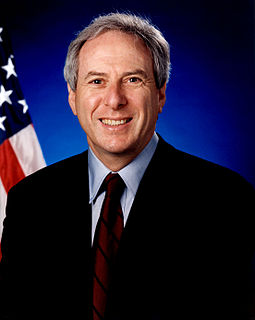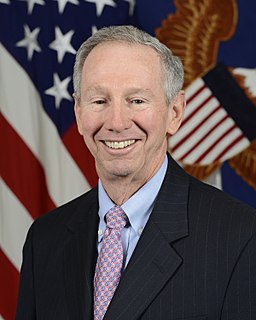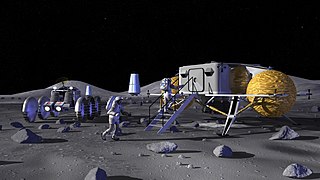Related Research Articles

Space exploration is the use of astronomy and space technology to explore outer space. While the exploration of space is carried out mainly by astronomers with telescopes, its physical exploration though is conducted both by unmanned robotic space probes and human spaceflight. Space exploration, like its classical form astronomy, is one of the main sources for space science.

Dennis Anthony Tito is an American engineer and entrepreneur, most widely known as the first space tourist to fund his own trip into space. In mid-2001, he spent nearly eight days in orbit as a crew member of ISS EP-1, a visiting mission to the International Space Station. This mission was launched by the spacecraft Soyuz TM-32, and was landed by Soyuz TM-31.

The Constellation program is a cancelled crewed spaceflight program developed by NASA, the space agency of the United States, from 2005 to 2009. The major goals of the program were "completion of the International Space Station" and a "return to the Moon no later than 2020" with a crewed flight to the planet Mars as the ultimate goal. The program's logo reflected the three stages of the program: the Earth (ISS), the Moon, and finally Mars—while the Mars goal also found expression in the name given to the program's booster rockets: Ares. The technological aims of the program included the regaining of significant astronaut experience beyond low Earth orbit and the development of technologies necessary to enable sustained human presence on other planetary bodies.

Daniel Saul Goldin served as the 9th and longest-tenured Administrator of NASA from April 1, 1992, to November 17, 2001. He was appointed by President George H. W. Bush and also served under Presidents Bill Clinton and George W. Bush.

The Vision for Space Exploration (VSE) was a plan for space exploration announced on January 14, 2004 by President George W. Bush. It was conceived as a response to the Space Shuttle Columbia disaster, the state of human spaceflight at NASA, and as a way to regain public enthusiasm for space exploration. It was replaced by the space policy of the Barack Obama administration in June 2010.

Michael Douglas Griffin is an American physicist and aerospace engineer who served as the Under Secretary of Defense for Research and Engineering from 2018 to 2020. He previously served as Administrator of NASA, the U.S. space agency, from April 13, 2005, to January 20, 2009. As NASA Administrator Griffin oversaw such areas as the future of human spaceflight, the fate of the Hubble telescope and NASA's role in understanding climate change. In April 2009 Griffin, who has an academic background, was named eminent scholar and a professor of mechanical and aerospace engineering at the University of Alabama in Huntsville.

On June 3, 2004, thirteen of the United States' premier space advocacy groups, industry associations and space policy organizations teamed up to form an umbrella organization known as the Space Exploration Alliance. The primary purpose of the SEA is to support the White House's plan to refocus NASA's human space activities toward exploration beyond low Earth orbit.

A Mars Sample-Return (MSR) mission is a proposed spaceflight mission to collect rock and dust samples on Mars and then return them to Earth. Sample-return would be a very powerful type of exploration, because the analysis is freed from the time, budget, and space constraints of spacecraft sensors.

The NASA Authorization Act of 2005 is an act of the United States Congress that requires NASA to carry out a balanced set of programs in human spaceflight, in aeronautics research and development and in scientific research. It was signed by the then President George W. Bush and became Public Law 109-155 on December 30, 2005.

The following outline is provided as an overview of and topical guide to space exploration:
DIRECT was a late-2000s proposed alternative super heavy lift launch vehicle architecture supporting NASA's Vision for Space Exploration that would replace the space agency's planned Ares I and Ares V rockets with a family of Shuttle-Derived Launch Vehicles named "Jupiter".

A lunar outpost is a concept of a permanent or semi-permanent presence of humans on the Moon, a moonbase, by the United States space administration NASA. NASA has requested an increase in the 2020 budget of $1.6 billion, in order to make another crewed mission to the Moon by 2024, followed by a sustained presence on the Moon by 2028.

The Space Exploration Initiative was a 1989–1993 space public policy initiative of the George H. W. Bush administration.

A human mission to Mars has been the subject of science fiction since the 1880s, and of aerospace engineering and scientific proposals since the late 1940s. Plans include landing on Mars for exploration at a minimum, with some considering exploring its moons Phobos and Deimos. Longterm proposals have included sending settlers and starting terraforming the planet.

The National Aeronautics and Space Administration is an independent agency of the U.S. federal government responsible for the civilian space program, as well as aeronautics and space research.

The Review of United States Human Space Flight Plans Committee was a group convened by NASA at the request of the Office of Science and Technology Policy (OSTP), to review the nation's human spaceflight plans to ensure "a vigorous and sustainable path to achieving its boldest aspirations in space." The review was announced by the OSTP on May 7, 2009. It covered human spaceflight options after the time NASA had planned to retire the Space Shuttle. A summary report was provided to the OSTP Director John Holdren, White House Office of Science and Technology Policy (OSTP), and NASA Administrator on September 8, 2009. The estimated cost associated with the review was expected to be US$3 million. The committee was scheduled to be active for 180 days; the report was released on October 22, 2009.

The space policy of the Barack Obama administration was announced by U.S. President Barack Obama on April 15, 2010, at a major space policy speech at Kennedy Space Center. He committed to increasing NASA funding by $6 billion over five years and completing the design of a new heavy-lift launch vehicle by 2015 and to begin construction thereafter. He also predicted a U.S.-crewed orbital Mars mission by the mid-2030s, preceded by the Asteroid Redirect Mission by 2025. In response to concerns over job losses, Obama promised a $40 million effort to help Space Coast workers affected by the cancellation of the Space Shuttle program and Constellation program.

The space policy of the United States includes both the making of space policy through the legislative process, and the implementation of that policy in the civilian and military US space programs through regulatory agencies. The early history of United States space policy is linked to the US–Soviet Space Race of the 1960s, which gave way to the Space Shuttle program. There is a current debate on the post-Space Shuttle future of the civilian space program.

The Artemis program is a U.S. government-funded international human spaceflight program that has the goal of landing the first woman and the next man on the Moon, specifically at the lunar south pole region, by 2024. The program is carried out predominantly by NASA, U.S. commercial spaceflight companies contracted by NASA, and international partners including the European Space Agency (ESA), the Japan Aerospace Exploration Agency (JAXA), Canadian Space Agency (CSA), the Italian Space Agency (ASI), the Australian Space Agency (ASA), the UK Space Agency (UKSA), the United Arab Emirates Space Agency (UAESA), the State Space Agency of Ukraine, and the Brazilian Space Agency (AEB). NASA is leading the program, but expects international partnerships to play a key role. Long-term goals include establishing an expedition team and a sustainable presence on the Moon, laying the foundation for private companies to build a lunar economy, and eventually sending humans to Mars.